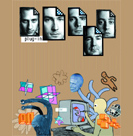design : motion-graphics : vfx
film+video+print+nu-media
news | projects | art | contact | blog
news
NEWS-FLASH: lost in space featured in blueprint special on new communicators
news-flash:lost in blueprint

once again lost in space is in news. its been a busy month for us in
the news with our cerillion piece being in SHOTS 70 and a profile on us
in zooworld's design wire.
this month we are featured in blueprint magazine, the bible of the architectural
and design world covering Contemporary architecture, design, art and culture,
has featured us in its new communicators issue.
the issue looks at people and companies whose vision embrace the digital world. together with such luminaries as peter murry founder of blue print, .... and ... lost in spaces article looks at how we are collectively pursuing our vision of hybridizing design and nu-media talent with moving image and visual effects skills to create a new vernacular for digital imagery.
read on!

The Digitrati The New Communicators
When Lost in Space founder and executive producer Christian Hogue talks
about some of the projects the firm is working on, you can just about
take in the breadth of what it does.
You nod appreciatively when he tells you Leo Marcantonio recently completed some cyber character designs for a TV series, that Rob Rae is holed up at Pinewood Studios working on the titles of the latest Bond film (which is why he’s missing from the photo line-up), while quietly progressing his episodic animated epic, “digmi” in his spare time. You nod when you hear that Lost in Space has done record covers for the likes of Muse and Roger Sanchez, along with commercials for Adidas on the one hand and accountancy firm KPMG on the other.
The company is also incubating the second phase of Noah Harris and Dan Capstick’s series of short films based on CCTV and surveillance, which have been screened on the big GMI screen in Leicester Square, London.
While trying to keep an eye on this bubbling sea of work and his energetic crew, Hogue continues to search out talent and follow up opportunities for work in Tokyo, Bangkok, LA and Sydney. He also found time to complete some experimental stills work recently with designer Sarah Harmarnee that will be featured in a forthcoming issue of BIG magazine.
When you hear all this, you think you’ve got a handle on things. Then someone asks: “So who is Lost in Space, what does it do?” And you start wittering incoherently about “digital stuff...um... record covers...err... James Bond” – and it doesn’t really come across. Its work doesn’t easily fit into a sound bite.
But the company has not always been quite so hard to pin down. Hogue, who’s from New Zealand, formed Lost in Space in the early Nineties as a digital effects business, steering the studio into design around 1998 when he became frustrated with his technical role. “I’ve always seen it as a creative resource rather than a service shop doing visual effects and animation,” he explains. In response, he set about investing in new design talent that showed promise in motion graphics.
“I take great satisfaction from creating an environment where talented people can express themselves. I recruit people whose skills I admire and who complement mine, or push the boundaries in directions I could never do,” explains Hogue.
Marcantonio was one of the first designers to come on board, helping out on a job for a couple of weeks, then just staying. He likes the fact that even Lost in Space’s bread-and-butter work keeps him learning while allowing him to play around. Marcantonio ’s work is “always experimental to start with, then when I’m told it’s too much, I experiment to make it more palatable”, he quips.
Lost in Space recently underwent a further incarnation from an employee-based studio into a looser model. This “virtual” studio, manned by Julian Saint Gerome in the Soho “control room”, allows designers the freedom to pursue their own projects and collaborate with other artists/designers, releasing the company from the responsibility of having to keep them constantly busy. “In many ways it’s made us more successful as a group,” says Hogue. As for the designers themselves: “I get more sleep,” says Marcantonio.
The future for Lost in Space is as fluid as the present. “The challenge is to apply our skills to the commercials market and generate enough critical mass to bootstrap us into content generation, short films, installation, interactive media and so on,” says Hogue.
He wants to get to a point where the studio is virtually running itself, leaving him with time to pursue his own projects. “There are several short films locked inside my straining brain waiting to be unleashed on the unsuspecting world,” he says. The world is waiting
Katy Greaves
Source: Blueprint June 2002
info@lostinspace.com
www.lostinspace.com